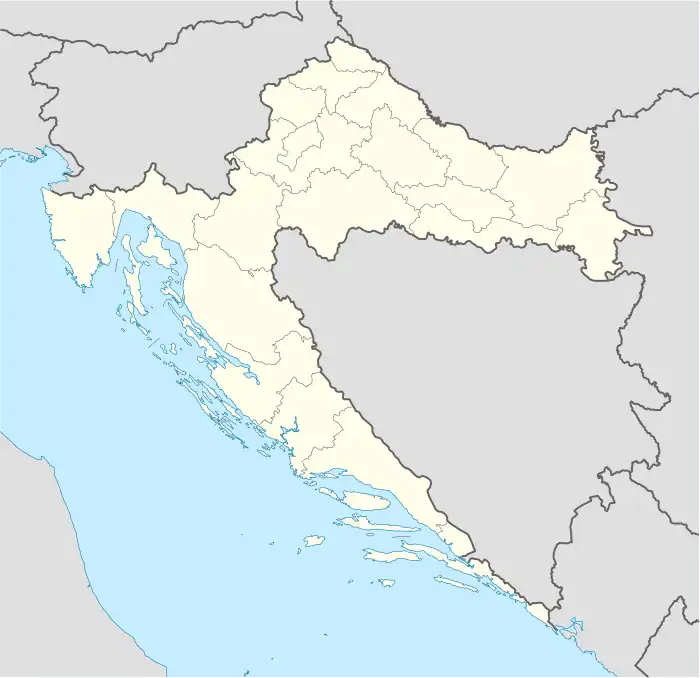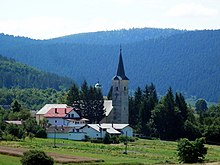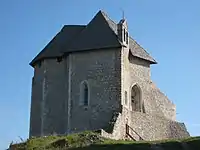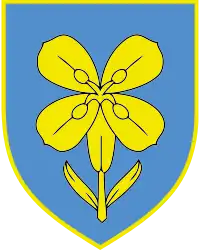Brinje
Brinje is a municipality in Lika-Senj County, Croatia. It is located about 20 kilometres (12 mi) east of Senj and 60 kilometres (37 mi) north of Gospić.
Brinje | |
|---|---|
 the Brinje municipality within Lika-Senj County | |
 Brinje Location of Brinje in Croatia | |
| Coordinates: 45.03°N 15.1308°E | |
| County | |
| Government | |
| • Mayor | Zlatko Fumić (HDZ) |
| Area | |
| • Total | 48.8 km2 (18.8 sq mi) |
| Population (2021)[2] | |
| • Total | 1,250 |
| • Density | 26/km2 (66/sq mi) |
| Time zone | UTC+1 (Central European Time) |
Geography
The town is formed around a castle called Sokolac, which contains one of the most well preserved Gothic chapels in Croatia, St. Marys, which dates back to the 14th century. The Sokolac Castle in the town is named after the Croatian word for falcon (sokol), which appears on the town's coat of arms.
History
Brinje's history dates back to medieval times, while the town was held by the noble Frankopan and Gorjanski families. Brinje was important medieval fortified city held by Frenkopan family.
In the late 19th century and early 20th century, Brinje was part of the Lika-Krbava County of the Kingdom of Croatia-Slavonia.
It is some 60 km north of Gospić, on once important road, the "Josephina", passing from the hinterland through the Kapela pass towards the coast in Senj. The new highway that is built brought much needed prosperity to Brinje.
Population

In the 2011 census, the Brinje municipality had a total of 3,256 inhabitants, in the following settlements:[4]
- Brinje, population 1,479
- Glibodol, population 6
- Jezerane, population 311
- Križ Kamenica, population 216
- Križpolje, population 510
- Letinac, population 154
- Lipice, population 154
- Prokike, population 102
- Rapain Klanac, population 20
- Stajnica, population 218
- Vodoteč, population 69
- Žuta Lokva, population 17
Politics
Minority councils and representatives
Directly elected minority councils and representatives are tasked with consulting tasks for the local or regional authorities in which they are advocating for minority rights and interests, integration into public life and participation in the management of local affairs.[6] At the 2023 Croatian national minorities councils and representatives elections Serbs of Croatia fulfilled legal requirements to elect 10 members minority council of the Municipality of Brinje but the elections were not held due to the absence of candidatures.[7]
Notable natives and residents
- Josif Rajačić
- Franjo Brozinčević
- Davor Lasić
References
- Register of spatial units of the State Geodetic Administration of the Republic of Croatia. Wikidata Q119585703.
- "Population by Age and Sex, by Settlements, 2021 Census". Census of Population, Households and Dwellings in 2021. Zagreb: Croatian Bureau of Statistics. 2022.
- Grahovac-Pražić & Vrcić-Mataija 2010, p. 82.
- "Population by Age and Sex, by Settlements, 2011 Census: Brinje". Census of Population, Households and Dwellings 2011. Zagreb: Croatian Bureau of Statistics. December 2012.
- "Population by Ethnicity, by Towns/Municipalities, 2011 Census: County of Lika-Senj". Census of Population, Households and Dwellings 2011. Zagreb: Croatian Bureau of Statistics. December 2012.
- "Manjinski izbori prve nedjelje u svibnju, kreću i edukacije". T-portal. 13 March 2023. Retrieved 10 June 2023.
- "Informacija o konačnim rezultatima izbora članova vijeća i izbora predstavnika nacionalnih manjina 2023. IX. LIČKO-SENJSKA ŽUPANIJA" (PDF) (in Croatian). Državno izborno povjerenstvo Republike Hrvatske. 2023. p. 6. Retrieved 13 June 2023.
Bibliography
- Grahovac-Pražić, Vesna; Vrcić-Mataija, Sanja (2010). "Ojkonimi gospićkog područja" (PDF). Folia Onomastica Croatica (in Croatian) (19): 81–96. Retrieved 25 December 2018.

